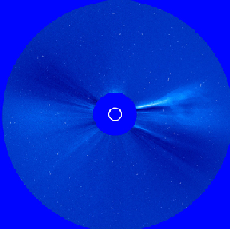
[ Coronagraphs and Occulters ] [ Diffraction ] [ Optics ]
![]()
The basic difference between a coronagraph and an occulter is the location of the occulting disk or shield.
 |
This image is of a coronal mass ejection, observed by Solar Terrestrial Relations Observatory (STEREO). A coronagraph blocks the bright disk of the Sun, allowing the much fainter corona to be seen. The white circle indicates the location and size of the solar disk. Image source: NASA. |
| Image Source: NASA |
A coronagraph is so named because it is typically used to view the Sun’s corona, by blocking out the light from the center of the star, allowing the much dimmer corona to be seen. A coronagraph is a telescope fitted with lenses and occulting shields inside the body of the telescope. This is the main difference between a coronagraph and an occulter. With an occulter, there is an occulting shield outside the body of the telescope that blocks out the light of an object in order to view fainter ones beside it. This is the idea with the New Worlds Observer mission.
A external occulter, or starshade, is flown in conjunction with a space telescope. Once the star, starshade, and telescope are aligned, the starshade blocks the light of the star, allowing the telescope to view the faint planets orbiting the star.
![]()
There are a number of positive aspects of using an external occulter instead of an internal coronagraph. The attributes are as follows:
![]()
- An external occulter substantially reduces the amount of light entering the telescope. In turn, this reduces the background light scattered into the focal plane, thus enhancing the planet detection limit.
- Since the occulter is not built into the telescope, scattered light is further reduced without additional optical surfaces and apertures. There are fewer internal obstructions within the telescope that could result in scattered light.
![]()
- When using an external occulter, the polishing tolerances of the primary mirror and supporting optics of the telescope can be less stringent. This provides higher contrast and fainter detection limits than are capable with a coronagraph.
- More relaxed metrology (measurement) requirements imply a lower required level of technology development. In other words, New Worlds Observer is technologically ready!
![]()
- Fewer optical surfaces also translate into less signal loss. This is especially important when searching for extremely faint planets.